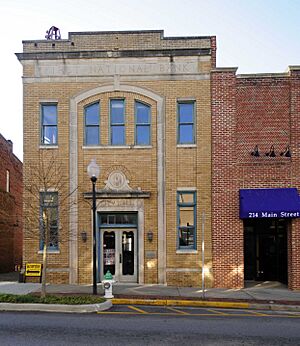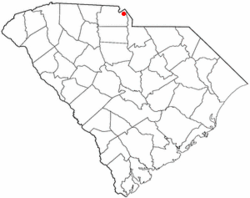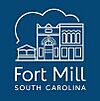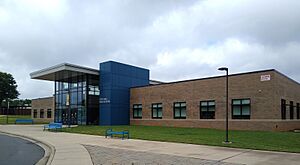Fort Mill, South Carolina facts for kids
Quick facts for kids
Fort Mill
Fort Mill Township
|
||
|---|---|---|

Fort Mill Downtown Historic District
|
||
|
||

Location in South Carolina
|
||
| Country | United States | |
| State | South Carolina | |
| Counties | York | |
| Established | 1873 | |
| Named for | Colonial-era British fort | |
| Government | ||
| • Type | Council–manager | |
| Area | ||
| • Total | 19.97 sq mi (51.72 km2) | |
| • Land | 19.71 sq mi (51.04 km2) | |
| • Water | 0.26 sq mi (0.68 km2) 1.30% | |
| Elevation | 623 ft (190 m) | |
| Population
(2020)
|
||
| • Total | 24,521 | |
| • Estimate
(2023)
|
33,626 | |
| • Density | 1,244.34/sq mi (480.43/km2) | |
| Time zone | UTC−5 (Eastern (EST)) | |
| • Summer (DST) | UTC−4 (EDT) | |
| ZIP codes |
29715, 29716, 29708
|
|
| Area code(s) | 803, 839 | |
| FIPS code | 45-26890 | |
| GNIS feature ID | 1247805 | |
Fort Mill, also known as Fort Mill Township, is a town in York County, South Carolina, United States. It's like a neighbor to Charlotte, North Carolina. In 2020, about 24,521 people lived here. Some nearby areas also use a Fort Mill address, but the town itself is only in York County.
Fort Mill is home to many cool businesses. These include the headquarters for Carolina Crown Drum and Bugle Corps, which won a world championship in 2013. Other big companies like LPL Financial, Continental Tire, and Domtar also have offices here. You can even find Puckerbutt Pepper Company, famous for creating super-hot peppers like the Carolina Reaper and Pepper X!
Contents
History of Fort Mill
The town of Fort Mill started in 1873. Its name comes from two old spots. One was a fort built by the British long ago to protect the Catawba Indians. The other was a place called Webb's Mill. The Catawba people lived in this area for many years.
In the 1750s and 1760s, settlers from Scotland and Ireland began to arrive. A small community quickly grew. Fort Mill became much bigger in the late 1800s when textile mills (factories that make cloth) were built. Even after many textile mills closed, the town kept growing fast. Today, it's a major suburb of Charlotte.
Key Moments in Fort Mill's Past
- In the mid-1700s, Thomas Spratt and his wife Elizabeth were the first white settlers in the Fort Mill area. They were invited to stay by the friendly Catawba Indians. Their family still lives there today. A descendant, John Spratt, even served in the U.S. House of Representatives.
- Fort Mill was the location of the last meeting of the Confederate Government Cabinet in 1865. This happened during the American Civil War. Jefferson Davis and his cabinet met at the White Homestead while trying to escape. Fort Mill also has a special monument in Confederate Park. It honors enslaved people who worked for the Confederate side during the war.
- In the 1970s and 1980s, Fort Mill was home to Heritage USA. This was a large Christian theme park and resort. It has since reopened as Heritage International Ministries.
Many historic places in Fort Mill are listed on the National Register of Historic Places. These include the Banks-Mack House, the Fort Mill Downtown Historic District, and the Unity Presbyterian Church Complex.
Geography and Climate
Fort Mill covers about 19.97 square miles. Most of this is land, with a small amount of water. Interstate 77 runs through the western part of town. South Carolina Highway 160 is the main road going east to west.
In 2008, Fort Mill grew even bigger when it added more land. The town has three golf courses. It also has six parks for everyone to enjoy:
- Harris Street Park
- Steele Street Park
- Doby Bridge Park
- Calhoun Street Park
- Veterans Park
- Walter Elisha Park
Three of these parks have picnic shelters, playgrounds, and restrooms. Some parks also have lighted baseball fields and basketball courts. Steele Street Park even has a small water park!
Fort Mill's Weather
Fort Mill has a humid subtropical climate. This means it has four seasons, but they are not as extreme as in some other places.
- In summer, daytime temperatures are usually around 90°F (32°C). Nights are around 70°F (21°C).
- In winter, daytime temperatures are about 50°F (10°C). Nights are near 30°F (-1°C).
- Sometimes, it can get very hot, over 100°F (38°C). It can also get very cold, below 0°F (-18°C).
- Summers are often humid with thunderstorms. Winters are rainy, and sometimes there's sleet or snow. Snow usually doesn't stay on the ground for long.
- Fort Mill can get rain from tropical cyclones. However, it's usually too far inland for strong winds. The last major hurricane to hit the area was Hurricane Hugo in 1989.
The most common type of soil in Fort Mill is called Cecil series.
Population and People
| Historical population | |||
|---|---|---|---|
| Census | Pop. | %± | |
| 1880 | 290 | — | |
| 1890 | 689 | 137.6% | |
| 1900 | 1,394 | 102.3% | |
| 1910 | 1,616 | 15.9% | |
| 1920 | 1,940 | 20.0% | |
| 1930 | 2,112 | 8.9% | |
| 1940 | 2,919 | 38.2% | |
| 1950 | 3,204 | 9.8% | |
| 1960 | 3,315 | 3.5% | |
| 1970 | 4,505 | 35.9% | |
| 1980 | 4,162 | −7.6% | |
| 1990 | 4,930 | 18.5% | |
| 2000 | 7,587 | 53.9% | |
| 2010 | 10,811 | 42.5% | |
| 2020 | 24,521 | 126.8% | |
| 2023 (est.) | 33,626 | 211.0% | |
| U.S. Decennial Census | |||
Fort Mill's Population in 2020
In 2020, Fort Mill had 24,521 people living in 6,130 households. About 4,854 of these were families.
| Race | Num. | Perc. |
|---|---|---|
| White (non-Hispanic) | 17,210 | 70.18% |
| Black or African American (non-Hispanic) | 2,965 | 12.09% |
| Native American | 81 | 0.33% |
| Asian | 1,294 | 5.28% |
| Pacific Islander | 4 | 0.02% |
| Other/Mixed | 1,296 | 5.29% |
| Hispanic or Latino | 1,671 | 6.81% |
Fort Mill's Population in 2010
In 2010, there were 10,811 people in Fort Mill. The town had 4,168 households.
- About 31.1% of the people were under 18 years old.
- The average age was 33.7 years.
- The median income for a family was about $79,495.
Economy and Jobs
Fort Mill is home to Bridgetree, a company that helps collect and manage data.
Fun Things to Do in Fort Mill
Fort Mill has many attractions. It's also close to bigger cities like Charlotte and Rock Hill, which offer even more activities.
- A part of Carowinds amusement park is located in Fort Mill.
- You can visit the Upper Room Chapel, which is a copy of the room where the Last Supper is believed to have happened.
- The Fort Mill Downtown Historic District has Confederate Park and Memorial Park. You'll also find many shops there.
- Every year, Fort Mill hosts the St. Phillip Neri Italian Festival. There's also the Strawberry Festival at Walter Elisha Park.
Fort Mill is also known for its peach orchards. The Anne Springs Close Greenway is a huge nature area. It has about 2,300 acres of lakes, forests, and fields. It's a great place for hiking, biking, and horseback riding.
Sports and Teams
Fort Mill is home to the PrimeTime Players. This is a minor league basketball team. They have won several championships in different leagues. They play their home games at Banks Street Gym.
The town is also home to Carolina Crown Drum and Bugle Corps. This group competes in Drum Corps International (DCI). Carolina Crown won a World Class championship in 2013. They have also won silver and bronze medals many times.
Schools and Learning
Fort Mill is the main community served by the Fort Mill School District. This district also includes students from nearby Tega Cay.
Fort Mill has a public library. It is a part of the York County Library system.
Famous People from Fort Mill
Many notable people have connections to Fort Mill:
- Steve Byrnes – A reporter for NASCAR on Fox.
- Ed Currie – The person who created the world's hottest peppers, the Carolina Reaper and Pepper X.
- Cheslie Kryst – She was crowned Miss USA 2019.
- Charlie Rymer – A golf commentator and a U.S. Junior Amateur winner.
- Elliot White Springs – A World War I flying ace, author, and businessman.
- Melvin Stewart – An Olympic swimmer and medalist.
- Vance Walker – An NFL defensive tackle for the Denver Broncos.
- James E. Williams – A Medal of Honor recipient.
- Ricky Wysocki – A 2016 disc golf world champion.
See also
 In Spanish: Fort Mill para niños
In Spanish: Fort Mill para niños



